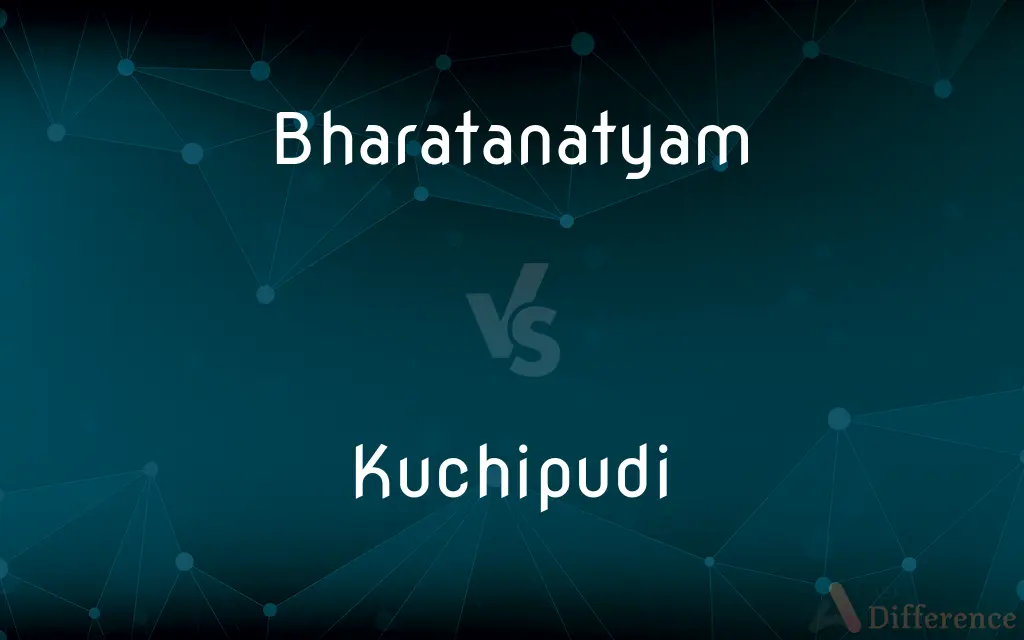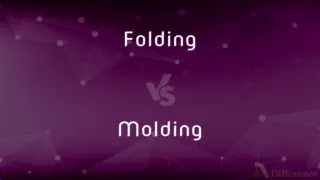Bharatanatyam vs. Kuchipudi — What's the Difference?
By Maham Liaqat & Fiza Rafique — Updated on March 24, 2024
Bharatanatyam emphasizes geometric lines and spiritual themes, while Kuchipudi combines fluid movements with expressive acting.

Difference Between Bharatanatyam and Kuchipudi
Table of Contents
ADVERTISEMENT
Key Differences
Bharatanatyam is known for its fixed upper torso, bent legs, and a focus on linear alignments of the body, alongside intricate footwork and sophisticated hand gestures (mudras) to convey various emotions and stories. On the other hand, Kuchipudi, hailing from Andhra Pradesh, India, is distinguished by its more fluid movements, expressive eye movements, and includes speaking parts and dramatic character portrayals. Kuchipudi performers often use props, such as brass plates and pots, and the dance is typically more theatrical, with dancers sometimes even balancing on the edges of moving plates.
While Bharatanatyam performances are usually solo, Kuchipudi can be performed as a solo or in a group, leading to a more diverse presentation. The former's music is predominantly Carnatic, characterized by a complex rhythmic structure and a rich melodic foundation. In contrast, Kuchipudi music also incorporates various regional folk traditions, providing a broader musical expressiveness.
Costuming in Bharatanatyam is tailored to enhance the dance's sculpture-like poses, featuring bright colored sarees made into a customized costume that includes pleats for showcasing intricate footwork. Kuchipudi costumes, while also vibrant, tend to be lighter and more suited for fluid movements, with added decorations that accentuate the dancer's expressions and movements.
The facial expressions (Abhinaya) in Bharatanatyam are used to express Rasa (emotional themes) with precision and depth, focusing on the spiritual aspect of storytelling. In contrast, Kuchipudi emphasizes more on dramatic expressions, often telling stories with a narrative focus, making the performances engaging through a combination of dance and dialogue.
Comparison Chart
Origin
Tamil Nadu, India
Andhra Pradesh, India
ADVERTISEMENT
Movement
Geometric, precise
Fluid, dynamic
Performances
Primarily solo
Solo and group
Music
Carnatic, complex rhythms
Incorporates folk, broader expressiveness
Costuming
Customized sarees, pleats
Lighter, decorative, suited for movements
Expressions
Spiritual, depth in emotions
Dramatic, narrative-focused
Compare with Definitions
Bharatanatyam
Spiritual Dance.
Bharatanatyam's movements and gestures are a form of prayer and devotion to the divine.
Kuchipudi
Use of Props.
Dancers often use props like brass plates, enhancing the visual spectacle.
Bharatanatyam
Mudras.
Hand gestures in Bharatanatyam convey stories and meanings, like the 'Lotus' pose symbolizing purity.
Kuchipudi
Theatrical Dance.
Kuchipudi combines dance with acting, bringing characters and stories to life.
Bharatanatyam
Linear Geometry.
The dance emphasizes straight lines and angles in its form and postures.
Kuchipudi
Expressive Eye Movements.
Eye movements in Kuchipudi are exaggerated to convey emotions and narratives.
Bharatanatyam
Temple Tradition.
Historically, Bharatanatyam was performed in temples as an offering to the gods.
Kuchipudi
Group Performances.
Kuchipudi can be performed in groups, creating elaborate and dynamic scenes.
Bharatanatyam
Solo Performance.
Bharatanatyam is traditionally performed solo, allowing a deep personal expression of spirituality.
Kuchipudi
Narrative Focus.
The dance form is known for its storytelling, often incorporating dialogues and dramatic elements.
Bharatanatyam
Bharatanatyam (Tamil:பரதநாட்டியம்) also called as Sadhir Attam, is a major form of Indian classical dance that originated in Tamil Nadu. It has flourished in the temples and courts of southern India since ancient times.
Kuchipudi
Kuchipudi () is one of the eight major Indian classical dances. It originated in a village named Kuchipudi in the Indian state of Andhra Pradesh.Kuchipudi is a dance-drama performance, with its roots in the ancient Hindu Sanskrit text of Natya Shastra.
Common Curiosities
What is Bharatanatyam?
A classical Indian dance form known for its spirituality, geometric poses, and expressive gestures, originating from Tamil Nadu.
Do Kuchipudi dancers use props?
Yes, props like brass plates and pots are commonly used in Kuchipudi to add visual interest and complexity.
Can Bharatanatyam be performed in a group?
While traditionally solo, modern Bharatanatyam performances sometimes include group arrangements.
What is the role of facial expressions in these dances?
Facial expressions convey emotional themes and narratives, with Bharatanatyam focusing on spiritual expressions and Kuchipudi on dramatic storytelling.
What stories do these dance forms tell?
Both dance forms convey religious and mythological stories, with Bharatanatyam focusing on Hindu deities and spiritual themes, while Kuchipudi often incorporates more varied narrative elements.
How does Kuchipudi differ in its approach to storytelling?
Kuchipudi integrates dance with dialogue and acting, creating a more explicit and engaging narrative experience.
What distinguishes Kuchipudi from Bharatanatyam?
Kuchipudi is more theatrical and fluid, with a focus on narrative and expressive acting, originating from Andhra Pradesh.
Is Kuchipudi a solo or group dance?
Kuchipudi can be performed both solo and as part of a group, offering versatility in presentation.
What kind of music accompanies Kuchipudi performances?
Kuchipudi music incorporates Carnatic and regional folk traditions, offering a wide range of musical expressiveness.
How important are costumes in these dance forms?
Both dance forms feature vibrant costumes that enhance the dance; Bharatanatyam's costumes emphasize geometric lines, whereas Kuchipudi's costumes are lighter and more suited for fluid movements.
What is the significance of the costumes in Kuchipudi?
The costumes in Kuchipudi are designed to be both beautiful and functional, allowing for the dynamic movements and expressions that characterize the dance.
What are mudras in Bharatanatyam?
Mudras are sophisticated hand gestures used to convey stories, emotions, and meanings in Bharatanatyam.
Can Bharatanatyam convey stories?
Yes, Bharatanatyam uses mudras and facial expressions to convey ancient stories and spiritual concepts.
What makes Kuchipudi's music unique?
Its combination of classical Carnatic music with regional folk traditions provides a broad and expressive musical palette.
How does the music in Bharatanatyam enhance the performance?
The complex rhythmic structures and rich melodic foundation of Carnatic music deeply enhance the spiritual and emotional expression in Bharatanatyam.
Share Your Discovery

Previous Comparison
Ferric vs. Ferrous
Next Comparison
Folding vs. MoldingAuthor Spotlight
Written by
Maham LiaqatCo-written by
Fiza RafiqueFiza Rafique is a skilled content writer at AskDifference.com, where she meticulously refines and enhances written pieces. Drawing from her vast editorial expertise, Fiza ensures clarity, accuracy, and precision in every article. Passionate about language, she continually seeks to elevate the quality of content for readers worldwide.













































